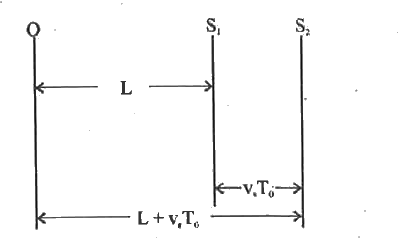Obtain an expression for the apparent frequency of sound for a source moving away and towards a stationary observer. Solution in Kannada
Let S1 be the position of the source at t= 0. Let L be the distance b/w the observed and the source at S,
Let v be the velocity of sound in air.
Time taken for sound ( say crest ) to reach the observer
t1=Lv ......(1)
Let the source travel further fromS1,and occupy the position S2 away from a stationary observer.
distance S1S2=vsT0
For a crest at S2 to reach the observer, it takes the time t2=T0+L+vsT0v ....(2)
At time nT, the source emits its (n+1)th crest and this reaches the observer at time.
tn+1=nT0+L+vs(nT0)v0
Time of observation of n crests by an observer will be nT.
nT=(nT0+L+nvsT0v)−(Lv)
Time for I crest = (nT0+LnvsT0v−Lv)+n
T=nvT0+L+nvsT0−Lnv
i.e, T=T0+vsT0v

or T=T0(v+vsv)
Apparent frequency of sound heard by a stationary observer for a source of sound moving away from him.
f=f0(vv+vs)
and apparent wavelength λ=v+vsf0 , change ( increase ) in wavelength.
Δλ=v+vsf0−vf0=(1f0)(v+vs−v)=vsf0
Percentage increase in λ=Δλλ×100=vsf0λ×100
For a source moving towards the observer , change vs to −vs
Then f=f0(vv−vs)
Apparent wavelength =v−vsf0, here λ<λ0
Topper's Solved these Questions
- WAVESBOOK - SUBHASH PUBLICATIONCHAPTER - WAVESEXERCISE - NUMERICALS WITH SOLUTIONS
46 Videos
- WAVESBOOK - SUBHASH PUBLICATIONCHAPTER - WAVESEXERCISE - THREE MARKS QUESTIONS WITH ANSWERS
5 Videos
- UNITS AND MEASUREMENTS BOOK - SUBHASH PUBLICATIONCHAPTER - UNITS AND MEASUREMENTS EXERCISE - NUMERICALS WITH SOLUTIONS
13 Videos
- WORK, POWER AND ENERGY BOOK - SUBHASH PUBLICATIONCHAPTER - WORK, POWER AND ENERGY EXERCISE - NUMERICALS WITH SOLUTIONS
33 Videos
Similar Questions
A string of mass 2.50kg is under a tension of 200N.The length of the stretched string is 20.0 m. If a transverse jerk is struck at one end of the string, how long does the disturbance take to reach the other end ?
View SolutionDistinguish between mechanical and non-mechanical waves with an example for each type.
View SolutionThe period of oscillation (T) of a simple pendulum depends on the probable quantities such as mass 'm' of a bob, length 'l' of the pendulum and acceleration due to gravity 'g' at the place. Derive an equation using dimensional analysis.
View SolutionThe K.E. of electron is 10 keV. Calculate its speed.
View SolutionAn observer moves towards a stationary source of sound, with a velocity one-fifth of the velocity of sound. What is the percentage increase in the apparent frequency?
View SolutionAn observer moves towards a stationary source of sound with a velocity one-fifth of the velocity of sound. What is the percentage increase in the apparent frequency?
View SolutionAn observer moves towards a stationary source of sound. The percentage change in the apparent frequency is
View SolutionWhen an observer moves away from a stationary source of sound, the apparent pitch will
View SolutionIf an observer moves towards a stationary source of sound with a velocity of one tenth the velocity of sound, then the apparent increase in frequency will be
View SolutionAn observer moves towards a stationary source of sound with a velocity on fifth of the velocity of sound, what is the percentage increase in the apparent frequency?
View SolutionWrite the expression for apparent frequency for source of sound moving towards a stationary observer.
View SolutionWrite the expression for apparent frequency of sound for observer moving towards a stationary source of sound.
View SolutionObtain an expression for the expparent frequency of sound for an observer moving towards // away from a stationary source of sound.
View SolutionAn observer moves towards a stationary source of sound with a velocity one-fifth of the velocity of sound. Calculate the percentage increase in the apparent frequency?
View SolutionAn observer moves towards a stationary source of sound with a velocity one-fifth of the velocity of sound. What is the percentage increase in the apparent frequency ?
View Solution
